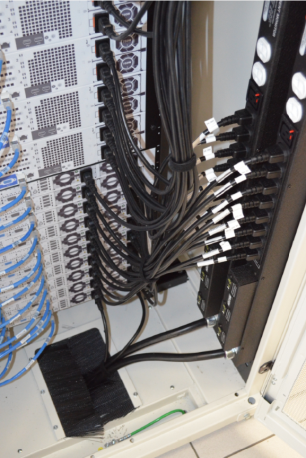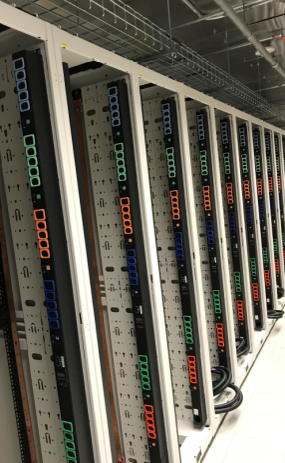10 Things to Consider When Choosing a Rack PDU
In their simplest form, rack power distribution units (PDUs) are designed to provide electrical protection and distribute power to networking equipment within racks/cabinets. As the needs and requirements of data centers change, so do options for rack PDU performance.
Today, there are several questions to consider before selecting rack PDUs that will work well for your data center application. This list below will help steer you in the right direction, ensuring that the PDUs you choose will fit the design of your data center today and in the future.

1. Type of mount
Depending on where you want to install it, a rack PDU can be mounted horizontally or vertically. Installed horizontally inside the rack (taking up RU space) is one option; another option is to vertically mount a PDU on the back or side of the enclosure (not taking up any RU space). You’ll often see one vertically mounted PDU on the left side and one on the right side of a data center cabinet (although rack PDUs can be mounted on either side, based on preferences).
PDUs can be mounted so that power cords exit either at the bottom or top of the enclosure. (If your data center is on a slab, for example, the power cord needs to exit at the top of the enclosure because there is no raised floor for it to pass through.)
2. Amperage
Your power rating – the amount of sustained power draw a PDU can handle – determines the amperage level you’ll need. Why is this important? Because, for example, a PDU with a 30A fuse will blow if a 30A circuit experiences more than 30A of power for an extended period of time.
Per the National Electrical Code, 30A PDUs or higher are required to be equipped with a 20A breaker to prevent injury in the event of a short circuit.
3. Voltage
In addition to different amperages, there are different input voltage options for rack PDUs as well; 208/240V is the most common voltage output to computing gear, with a new trend moving toward 400V input. Confirm your infrastructure voltage, and you’ll know what type of voltage you need in your PDU.
4. Single- or 3-Phase power
What type of input power do you have access to: single-phase power or 3-phase power? The type of power distribution in your data center will determine whether you need a single- or 3-phase PDU.
The difference involves where in the distribution system the phase is broken down. When it’s broken down at the distribution panel, power to the rack will be single-phase service (requiring single-phase rack PDUs). When all three phases are brought to each rack, then a 3-phase PDU is needed. In most data centers, the input power is 3-phase service.
5. Plug type
Here in North America, you’ll most often see NEMA-style plugs (locking) on rack PDUs. Locking plugs are popular to secure electrical connections and prevent accidental disconnection. The other option is an IEC-style plug. A third plug type, known as the California-style plug, is sometimes seen in North American data centers as well (normally used for 50A circuits). PDUs with this plug type can also be found.

6. Power cord length
Standard power cord lengths vary based on the manufacturer, but this can often be a customizable option. Belden’s standard, for example – and the standard from most manufacturers – is 10 feet, but we’ve created rack PDUs with power cords of up to 40 feet or longer when needed. The length of your power cord is determined, of course, by how far it needs to reach to connect.
To limit power loss, it’s important to keep connection points to the DC distribution system as close to the cabinet as possible. UL limits the length of the power cord to 15 feet; longer cords may call for a rack PDU to be equipped with a terminal block and cord that is installed onsite by an electrician.
7. Receptacle count/type
The number of receptacles you need shouldn’t be based solely on the number of devices there are to plug in right now – it should also take future rack growth into account. Although customized options are available when it comes to receptacle count, it typically makes the most financial sense to choose from a standard option. Because they can be longer, vertically mounted PDUs tend to offer more receptacles per unit.
The number of receptacles in a rack PDU is often balanced per phase (which is why you see 24-, 30- and 42-count receptacles – they’re all divisible by three for 3-phase power).
It’s also important to determine the types of plugs being used on the devices in your rack. Most computing gear use C-13 or C-19 input cords, for example, so it’s important to determine the needed ratio in your rack PDU.
8. Local meters
PDUs with a local meter display are standard-grade rack PDUs. They indicate when circuits are approaching maximum capacity and breakers may trip. When you know how much amperage is being pulled from the PDU, you can make decisions accordingly and stay on top of potential problems.
9. Remote monitoring
If you want to know more than just the amperage being pulled from your PDU – and want to know that data without having to look at the PDU – a device with remote-monitoring capabilities may be what you need. It will include the voltage, amperage and power being drawn. (In a 3-phase rack PDU, you’ll see the power draw for each of the three phases.) Rack PDUs can remotely monitor at the aggregate level, phase/circuit level or outlet level. Depending on the options you select, this can help support granular power usage effectiveness (PUE) reporting. It can also help calculate individual customer power usage for billing, if needed.
Based on parameters you set, the monitoring system can even send alerts when the PDU is reaching circuit capacity or isn’t performing correctly.
10. Remote switching
If the option to remotely switch receptacles on and off is important to you, remote switching is available on some rack PDUs. This provides data center managers with better control: individual outlets can be remotely turned on and off, and gear reboots can be managed remotely.
After thinking about these 10 criteria, you should have a good idea about what features and options you need from a rack PDU. If you can’t find a standard PDU that matches what you need, Belden can customize a solution – like it has for data centers all over the world. Learn more about our customized data center infrastructure solutions.
